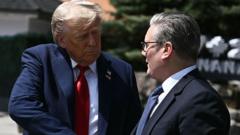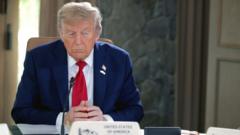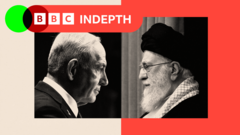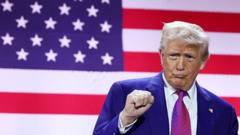As millions of Canadians cast their votes on April 28, 2025, the atmosphere is charged with uncertainty, following a turbulent period marked by President Trump's trade war and recent political shifts. The stakes are high with the future direction of the country in the balance.
Canada's Election Day: A Pivotal Moment Amid Uncertainty

Canada's Election Day: A Pivotal Moment Amid Uncertainty
Canadians face significant choices in a historic election influenced by turmoil in both local and international arenas.
Canadians are heading to the polls amidst a charged political climate that echoes with the repercussions of President Trump’s provocative stance on trade and sovereignty. This election, slated for April 28, is consequential as voters decide whether to continue the trajectory set by the Liberal Party, now led by Prime Minister Mark Carney, or pivot towards the Conservative Party under Pierre Poilievre.
Recent polls indicate a tight race, with Carney’s Liberals gaining a slight lead over Poilievre’s Conservatives, an unexpected turn given that just three months ago, polls showed the latter leading by a wide margin. The sudden shift in public opinion can be attributed to Carney's emergence and Trump's aggressive trade policies, which have turned the election into a referendum on Canada’s response to American pressures.
While Canadians prepare to select their local representatives to the House of Commons, several smaller parties, including the New Democratic Party and the Green Party, are also vying for seats, though they are not expected to make significant headway in this election. Traditionally, Canada’s first-past-the-post election system means that a party can form a government without holding a majority of the popular vote, depending on how votes are distributed across the country.
The candidates offer starkly different visions for Canada. Mark Carney, the incumbent prime minister, is framing his credentials in finance and diplomacy as critical assets for navigating a turbulent economic landscape, particularly with respect to Trump’s tariffs. In contrast, Pierre Poilievre emphasizes a smaller government, deregulation, and a return to conservative principles, appealing to voters frustrated with rising costs and perceived government overreach.
September 2024 saw Trudeau resigning as prime minister, previously the Liberal leader for a decade, which many view as the catalyst for the Liberal party's renewed focus on economic concerns over social issues that had earlier marked their agenda. With inflation and affordability front of mind for many voters, Carney aims to project a more centrist approach to draw reluctant Liberal supporters back into the fold while addressing U.S. threats.
With polls set to close at 9:30 PM EDT, the results will likely trickle in throughout the night. As Canadians make their choices, concerns about misinformation and disinformation campaigns, particularly on social media, haunt the discourse. The election comes at a time when Canada’s online ecosystem has been dramatically impacted by Meta’s decision to block news from its platforms, leading to new sources filling the void with hyperpartisan and sometimes misleading information.
As Canadians head to the polls, they face a decision that may define the country’s future amidst a backdrop of economic precariousness and ongoing international tensions. Who will emerge as the leader able to handle the tumultuous landscape and guide Canada forward?
Recent polls indicate a tight race, with Carney’s Liberals gaining a slight lead over Poilievre’s Conservatives, an unexpected turn given that just three months ago, polls showed the latter leading by a wide margin. The sudden shift in public opinion can be attributed to Carney's emergence and Trump's aggressive trade policies, which have turned the election into a referendum on Canada’s response to American pressures.
While Canadians prepare to select their local representatives to the House of Commons, several smaller parties, including the New Democratic Party and the Green Party, are also vying for seats, though they are not expected to make significant headway in this election. Traditionally, Canada’s first-past-the-post election system means that a party can form a government without holding a majority of the popular vote, depending on how votes are distributed across the country.
The candidates offer starkly different visions for Canada. Mark Carney, the incumbent prime minister, is framing his credentials in finance and diplomacy as critical assets for navigating a turbulent economic landscape, particularly with respect to Trump’s tariffs. In contrast, Pierre Poilievre emphasizes a smaller government, deregulation, and a return to conservative principles, appealing to voters frustrated with rising costs and perceived government overreach.
September 2024 saw Trudeau resigning as prime minister, previously the Liberal leader for a decade, which many view as the catalyst for the Liberal party's renewed focus on economic concerns over social issues that had earlier marked their agenda. With inflation and affordability front of mind for many voters, Carney aims to project a more centrist approach to draw reluctant Liberal supporters back into the fold while addressing U.S. threats.
With polls set to close at 9:30 PM EDT, the results will likely trickle in throughout the night. As Canadians make their choices, concerns about misinformation and disinformation campaigns, particularly on social media, haunt the discourse. The election comes at a time when Canada’s online ecosystem has been dramatically impacted by Meta’s decision to block news from its platforms, leading to new sources filling the void with hyperpartisan and sometimes misleading information.
As Canadians head to the polls, they face a decision that may define the country’s future amidst a backdrop of economic precariousness and ongoing international tensions. Who will emerge as the leader able to handle the tumultuous landscape and guide Canada forward?






















